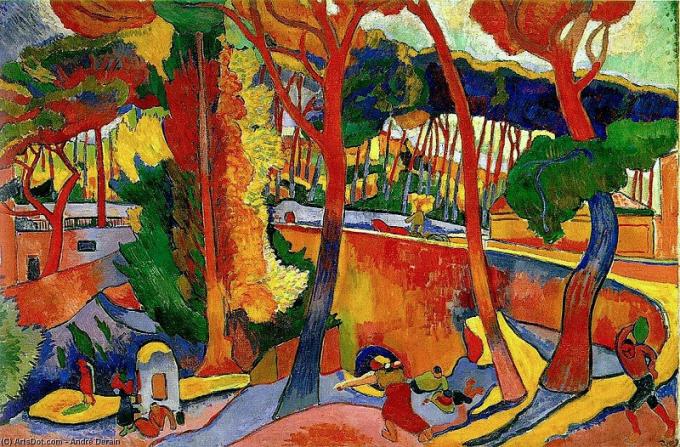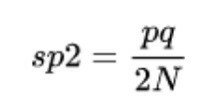Fauvism: what it is, and characteristics of this artistic movement
On October 18, 1905, the so-called Autumn Salon was inaugurated at the Grand Palais on the Champs-Élysées in Paris. Although this exhibition had started in 1903, the one in 1905 was something special. And it is that that was the year in which the most innovative artists, many of them coming from the school of the symbolist Gustave Moreau, entered the exhibition catalogue. Among these artists were fauves, the beasts".
Why were they called that, and who gave them this curious name? Who were these "Fauves" and what did their work mean for the future avant-garde of the 20th century? In this article we propose a journey to the heart of what is considered the first avant-garde movement: fauvism.
What is fauvism?
"Fauvism" comes from the French word fauve, which means "beast, wild animal." In truth, the name was perfectly suited to this group of artists, since their canvases, of garish and strident colors, had shaken the corseted bourgeois society.
This was nothing new. A few years before, Van Gogh and Gauguin had revolutionized the world of painting; Cézanne, who was admired by the Fauves, had also marked a before and after in the art scene at the end of the century. But what was a real shock for academics was coming face to face with the works of these innovative artists at the Salon d'Automne in 1905. A whole cascade of bright colors and without nuances that, without a doubt, impressed the public.
Of course, not all the astonishment was positive. Louis Vauxcelles, art critic, was the one who consecrated the group definitively through his famous phrase: “Donatello among beasts”. The comment referred to the fact that in the famous room VII of the exhibition, there was a classical sculpture, surrounded by paintings by Fauvist painters. Vauxcelles was greatly impressed by the contrast offered by the serenity of the Renaissance forms of the sculpture. (which, by the way, had been done by Marquet, a Fauvist) and the stridency of the colors of the canvases that they wrapped. Thus, the name of the movement, "Fauvism", was established for posterity.
- Related article: "What are the 7 Fine Arts?"
The “first vanguard”
Fauvism has commonly been called the first avant-garde of the 20th century. This, however, is not so. And it is not for an essential reason: The Fauves, unlike the later vanguards, did not at any time form a solid or cohesive movement. They didn't even have clear guidelines to follow (much less a theoretical manifesto), so each of the artists belonging to the group followed their own path. That is why Fauvism, strictly speaking, barely lasted a couple of years (from 1905 to 1907), despite the fact that his influence on subsequent movements was enormous, as we will see later. forward.
The origin of the Fauves can be found in the School of Fine Arts in Paris, where Gustave Moureau (1826-1898) taught. Moureau was one of the great representatives of symbolism and decadence, and had a powerful influence on the painting of three of his students: Henri Matisse (1869-1954), Georges Rouault (1871-1958) and Albert Marquet (1875-1947). These three artists would be the nucleus of the later Fauvist movement, to which the painters of the so-called Chatou school (André Dérain and Maurice de Vlaminck) and those of Le Havre (Othon Friesz, Raoul Dufy, Georges Braque and Kees van Dongen). These young painters converge in the famous Berthe Weill art gallery, and there they become friends and share impressions about the present and the future of art.
characteristics of fauvism
It can be said that what truly united the Fauves was a sincere friendship and common affinities, but never a solid and structured artistic theory, as the surrealists or the futurists. The Fauves shared an enthusiasm for color as a primary means of expression, following in the footsteps of their admirers Van Gogh and Gauguin., as well as a love for the artistic manifestations of primitive peoples and for children's art. Not in vain, the already mentioned Louis Vauxcelles affirmed that the Fauvist paintings resembled "a child playing with a box of colours".
The Fauves felt an uncontrollable passion for life, for pleasure and hedonism. The painting was an exaltation of that joy, of that beauty to which they wanted to sing, which united them closely to the aesthetic movement of "art for art's sake", to which, by the way, his teacher belonged, Gustave Moreau. That joy of life is expressed mainly through color. Fauves apply colors directly from the tube; there is no prior mixing or study of shades. Thus, a tree can be red, a river can have a beautiful emerald green and a mountain can be painted canary yellow. In the Fauves, color is no longer subservient to reality, and its liberation is the artist's own liberation.
In the summer of 1905, a few months before the exhibition that brought them name and fame, Henri Matisse and André Derain met in Collioure. Over there dedicated to reproducing on canvas the lights and cheerful tones of the Mediterranean; The result is true explosions of colours: the Views of Collioure from Dérain, where the colors of the port and the houses are transformed and acquire their own personality; and, above all, the famous the open window, by Matisse, where the spots of pure color insinuate, through a window frame, the sea and the town's boats.
- You may be interested in: "The 8 branches of the Humanities"
Color as protagonist
We have already commented that these innovations with color and light were not new. A few decades ago, the Impressionists had revolutionized the painting scene with their fast, loose brushstrokes. But the true Fauvist innovation is color, which acquires an aggressiveness and autonomy never seen before on his canvases. The public of the time is not used to it; Fauvist colors “hurt” the eyes of those who look at them.
In the famous painting woman with hat, also from the summer of 1905, Matisse portrays his wife in thick patches of colour. The color is the form; everything revolves around him. The portrait of Madame Matisse, an authentic orgy of colors, is even more surprising if we take into account that the lady was dressed in black...
Even more revolutionary is the canvas the green stripe (1905), also by Matisse, where he again represents his wife. The name of the painting comes from the elongated green spot that furrows the wife's forehead and nose. The color captured on the canvas is daring and unreal, on the one hand; on the other, the face of Madame Matisse is executed following the style of African masks, which were so in vogue at the time.
In Houses and Trees (1906), by Maurice de Vlaminck, the importance that Fauvism gives to color is evident in the tangle of brushstrokes that populate the canvas. Among such a knot of colors, the houses of the title are completely hidden and blend in with the sky, the trees and the sea.
- Related article: "What is creativity? Are we all "would-be geniuses"?"
the stages of fauvism
J. Elderfield, an art curator, has established two very clear phases in the evolution of Fauvism. The first would cover the period from 1905 to 1906, coinciding with the autumn exhibition and the following months, and would be characterized by mixed technique. During this stage, the Fauves find (or try to find) a synthesis between divisionism (that pointillist brushstroke of painters like Seurat) and chromatic freedom. The aforementioned Collioure works by Henri Matisse and André Dérain are clear examples of this mixed technique, which combines short, divided brushstrokes with much longer, thicker ones.
The second (and last) stage of Fauvism is the one that goes from 1906 to 1907. It coincides with the incorporation of the Le Havre group (Friesz, Dufy, Van Dongen, Braque), and is characterized by a “stabilization” of the shapes and chromatic areas. This is what has been called “flat color fauvism”. The canvases continue to present bright and striking colors, but not as strident as those of the previous stage. Some representative works of this stage are The street festooned with flags in Le Havre (1906), by Raoul Dufy, or The curve of the road in l'Estaque (1906), by Andre Derain.

Fauvism in the rest of Europe
So far we have referred only to the French Fauvist movement. However, The group's influence crossed borders, and we find Fauvist expressions in Germany, the Nordic countries and even in Spain..
In June 1905, some students from the Higher Technical School of Architecture founded an artistic group in Dresden: die brucke (The Bridge). It includes names like Ernst Ludwig Kirchner (1880-1938), Erick Heckel (1883-1970) and Karl Schimdt-Rottluff (1884-1976). It is especially Kirchner who will have the most renown as he later becomes one of the greatest exponents of German Expressionism.
Although Kirchner himself did not like that they pointed out the influence of the French Fauves in his first work, the truth is that this fact cannot be denied. The first works of "El Puente" found their roots in the precepts of the freedom of color as the only vehicle of expression. We see it in works like Girl under a Japanese umbrella (1909), by Kirchner, or in Young woman lying on a sofa (1909), by Heckel, although it is true that German Fauvism is much more forceful and expressive than French. The faces of the characters, for example, prefigure the imminent expressionism.
On the other hand, in Munich we find Alexej von Jawlensky (1864-1941) and, above all, Wassily Kandinsky (1866-1944) who, long before opting for abstraction, played with figurative works of clear influence fauvist.
Nordic Fauvism has in Emil Nolde (1867-1956) one of its greatest exponents. His Dance around a golden calf (1910) already has an undeniable expressionist force. For his part, in Spain Francisco Iturrino (1864-1924) is one of the most influential artists fauve. In the years 1911 and 1912 he stayed in Morocco in the company of Henri Matisse, where he studied light and new pictorial possibilities.
The "death" of Fauvism
As a movement, Fauvism lasted just two years, from 1905 to 1907. The Salon d'Automne of 1907 is crucial for the Fauves: it represents both their consecration and their swan song. As of that date, its members disperse and take different paths. Braque, for example, finally embraces cubism; others, like Dérain and Matisse, immersed themselves in the study of primitivism and the work of their idol, Paul Cézanne. In this period immediately after the dismemberment of the Fauvist group, Henri Matisse paints what will be one of his masterpieces: Dance (1909). In it, one can already see that desire to return to that lost and longed-for Arcadia that would characterize Matisse so much in the years after 1907. Fauvist passion has cooled, and now art for him is something that should evoke calm and tranquility.


